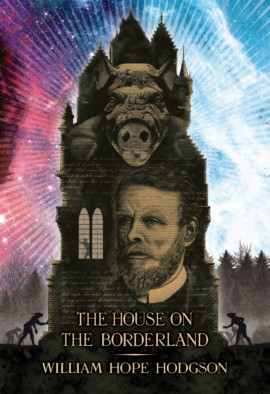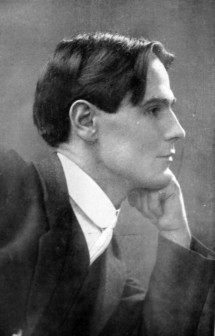The House on the Borderland
William Hope Hodgson
Availability: In Print – Paperback, Out of Print – Hardback
I am an old man. I live here in this ancient house, surrounded by huge, unkempt gardens.”
An exiled recluse, an ancient abode in the remote west of Ireland, nightly attacks by malevolent swine-things from a nearby pit, and cosmic vistas beyond time and space. The House on the Borderland has been praised by China Miéville, Terry Pratchett, and Clark Ashton Smith, while H. P. Lovecraft wrote, “Few can equal [Hodgson] in adumbrating the nearness of nameless forces and monstrous besieging entities through casual hints and significant details, or in conveying feelings of the spectral and abnormal.”
“Almost from the moment that you hear the title,” observes Alan Moore, “you are infected by the novel’s weird charisma. Knock and enter at your own liability.” The House on the Borderland remains one of Hodgson’s most celebrated works. This new edition features an introduction by Alan Moore, an afterword by Iain Sinclair, and illustrations by John Coulthart.
- Listen to Jon Mueller’s soundtrack for the novel online and buy a digital copy here.
Our limited edition hardback is sold out.
Please check with our Booksellers for remaining copies.
Cover and illustrations by John Coulthart
Introduction by Alan Moore
Afterword by Iain Sinclair
ISBN: 978-1-78380-021-6 (hbk)
ISBN: 978-1-78380-739-0 (pbk)
Contents
“Fear of a Porous Border: William Hope Hodgson’s Liminal Masterpiece” – Alan Moore
“The House on the Borderland” – William Hope Hodgson
“An Abberrant Afterword: Blowing Dust in the House of Incest” – Iain Sinclair
“Acknowledgements”
William Hope Hodgson
William Hope Hodgson was born in Blackmore End, Essex on 15 November 1877. Though distinguished as a sailor, body builder, photographer, and soldier, Hodgson is now remembered as a writer of the fantastic and macabre: The Boats of the “Glen Carrig” (1907), The Ghost Pirates (1909), The Night Land (1912), and the occult detective stories in Carnacki, the Ghost Finder (1913). Hodgson’s literary career was tragically cut short by an artillery shell at the Battle of Ypres in late April 1918.
Read more“To commemorate this sad anniversary, the Swan River Press has issued an exceptional new edition of Hodgson’s most famous novel . . . To gauge something of the novel’s power, imagine a psychedelic expansion of Poe’s ‘The Fall of the House of Usher’.” – Michael Dirda, Washington Post
“Anyone in the future considering reprinting The House on the Borderland can now pack it in and give up the ghost, because Swan River Press has produced the best version ever. There is no need for any other, for none will match this triumph.” – Dead Reckonings
“The House on the Borderland by William Hope Hodgson. Adored by HPL. A summit of Cosmic horror. Scary, disturbing and magical.” – Guillermo del Toro
“Among connoisseurs of fantasy fiction William Hope Hodgson deserves a high and permanent rank . . . [The House on the Borderland is] perhaps the greatest of all Mr. Hodgson’s works.” – H. P. Lovecraft
“My granny thought that they occasional doses of mindless terror were just what a healthy, growing boy needed. She let me work my way along the Conan Doyles and the Vernes. Just when I thought it was all going well, she hit me with Hodgson . . . . [The House on the Borderland] was the Big Bang in my private universe as a SF/fantasy reader and, later, writer.” – Terry Pratchett
“Almost from the moment that you hear the title you are infected by the novel’s weird charisma . . . Knock and enter at your own liability.” – Alan Moore
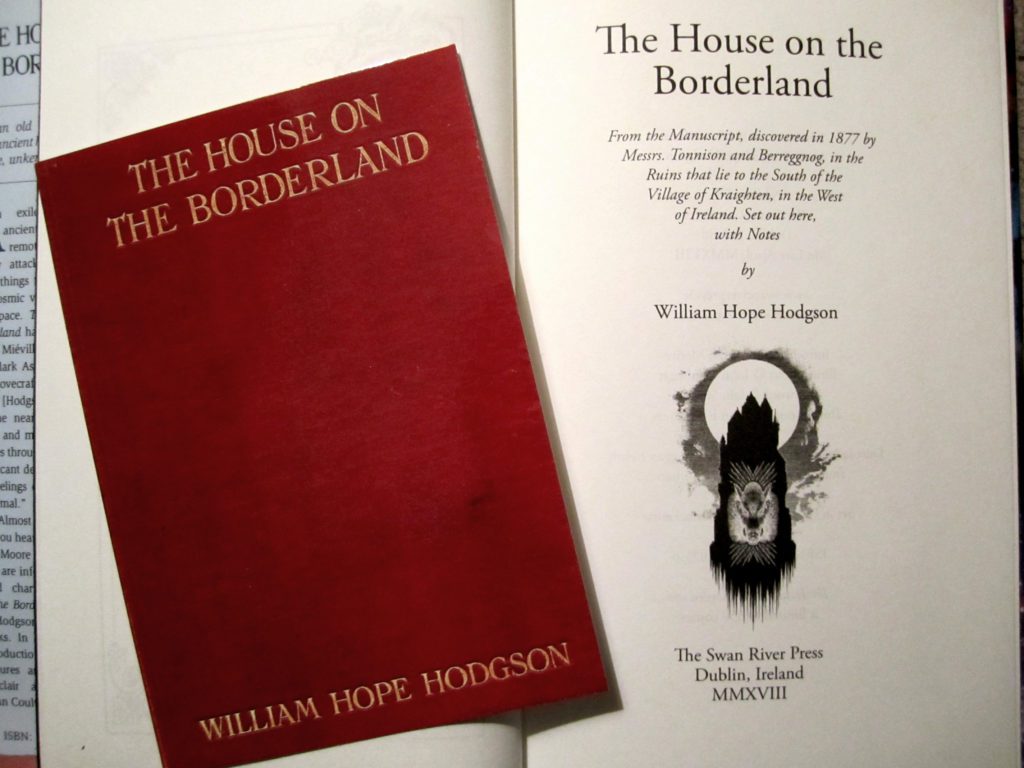
The House on the Borderland by William Hope Hodgson. Cover art and interior illustrations by John Coulthart; jacket design by Meggan Kehrli; introduction by Alan Moore; afterword by Iain Sinclair; edited by Brian J. Showers; copyedited by Jim Rockhill; typeset by Ken Mackenzie; published by Swan River Press.
Hardback: Published on 10 April 2018; limited to 350 copies of which 100 are embossed and hand numbered; xvii + 198 pages; lithographically printed on 80 gsm paper; dust jacketed; illustrated boards; ten interior illustrations; sewn binding; head- and tail-bands; issued with three postcards and a compact disc; ISBN: 978-1-78380-021-6. Three hundred copies of the limited edition hardback were signed by Alan Moore, John Coulthart, and Iain Sinclair.
Each copy of the hardback included a CD of original music, composed and performed by multi-instrumentalist Jon Mueller (Volcano Choir, Death Blues) especially for this reissue. Track Listing: I. From That Strange Source of Light; II. The Speed of My Passing Spirit; III. Then a Door Opened Somewhere Ahead. You can listen to the album online and buy a digital copy here.
Paperback: Published on 15 October 2020; no limitation; print on demand paperback; ISBN: 978-1-78380-739-0.
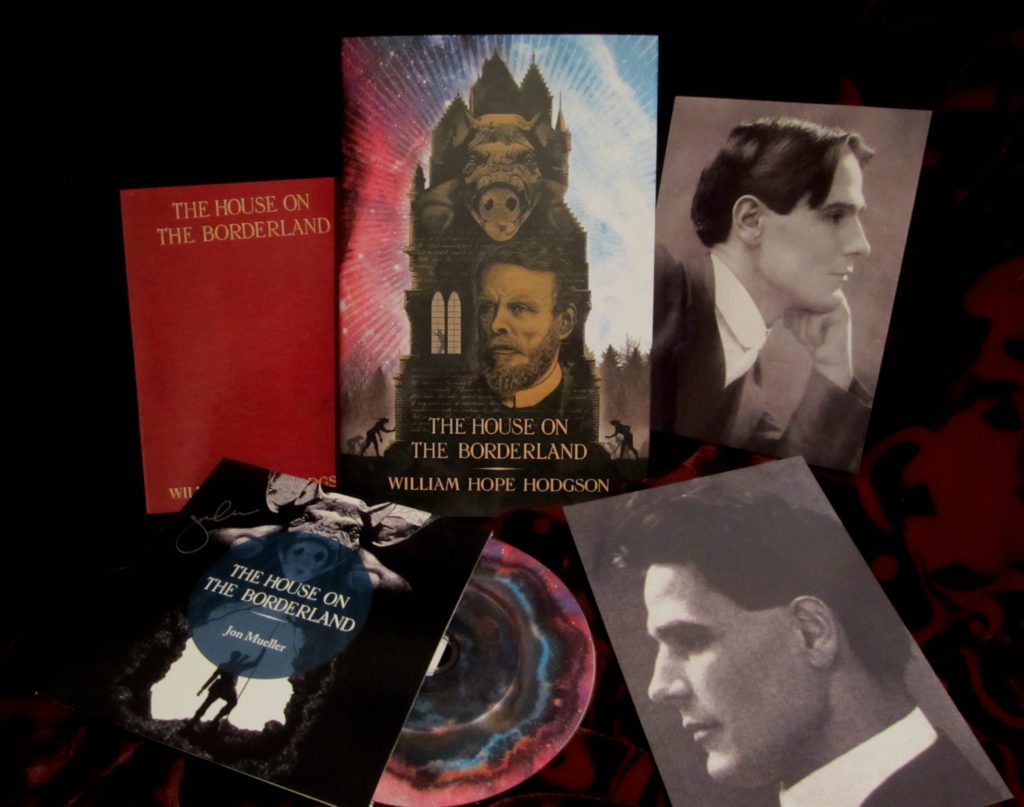
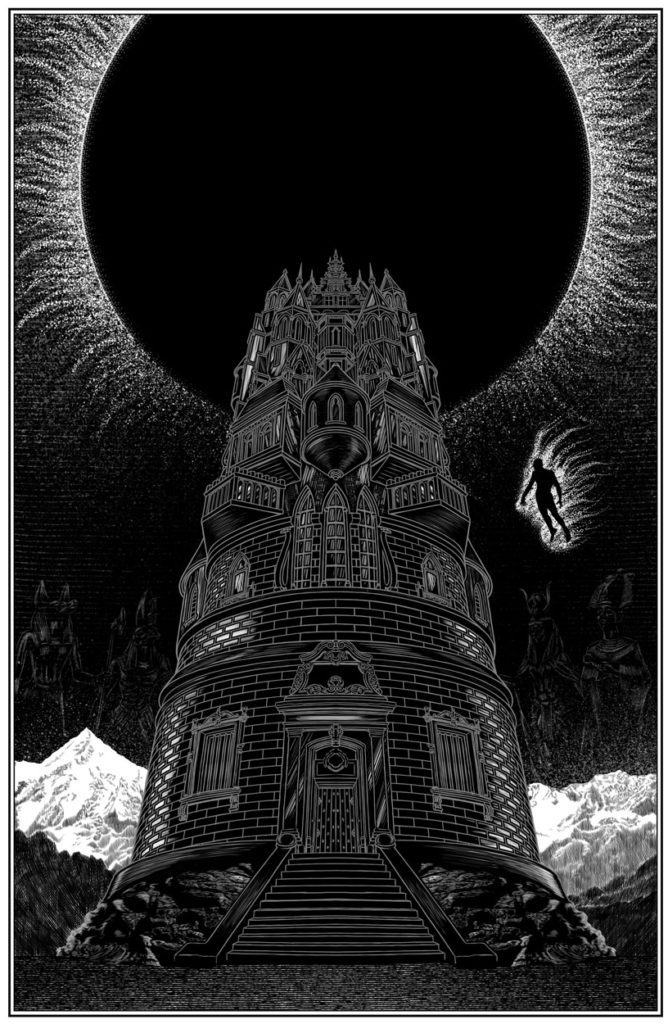 “Coulthart and Mueller on the Borderland”
“Coulthart and Mueller on the Borderland”
Conducted by Brian J. Showers, © April 2018
Brian J. Showers: Do you recall the first time you read William Hope Hodgson’s The House on the Borderland?
John Coulthart: Yes, I was about twenty at the time. I’d been reading ghost and horror stories from the age of ten but it took me a while to get round to Hodgson after being alerted by Lovecraft’s “Supernatural Horror in Literature”. The first copy I found was the notoriously disgraceful 1977 paperback from Manor Books, the cover of which is still the worst of all the House on the Borderland covers. The quote from Lovecraft has his name printed at a much larger size than Hodgson’s; the house is a typical American farm in a dustbowl landscape, while the foreground of the cover painting is occupied by a preposterous corncob. If I hadn’t been so eager to read the book I would have refused to pay the mere 25p it was selling for. I was further aggrieved when I found the 1972 Panther edition (with excellent cover art by Ian Miller) to discover that Manor Books had omitted the opening poem and some of the novel’s other front matter. An inauspicious introduction.
Jon Mueller: I only just discovered the book within the last four years or so. I stumbled upon a mention of Hodgson in an article, and was surprised I had never heard of him. The article suggested that The House on the Borderland was his best work, so I figured I’d start there. I couldn’t help but see the similarity between the two men in the story, discovering the central character’s journal, and my discovery of Hodgson’s book. Both seemingly random, yet somehow fated. From there, this realisation grew to surreal heights as I too got lost in the nightmarish (not just descriptively, but literally) world of its story. Like the two men in the book, it consumed me. I wondered about the central character, his dog, the beasts, and what was happening as the universe seemed to implode within the house, and even within them. I walked away from the end of the book feeling like I was really woken from reality. That a whole other layer of existence was all around me. John, do you remember what your initial takeaway was?
Coulthart: Now that the book is so familiar it’s difficult for me to recall an initial impression other than one of surprise at the sudden change of tone halfway through. Any book that begins with a kind of adventure narrative—even one involving monstrous entities—can be relied upon to develop fairly predictably but that’s not what we find here. I was also impressed by the lack of resolution or tidy explanation, an unusual thing in genre novels even today. The inexplicabilities at the heart of the novel are a persistent attraction.
Showers: When I first read The House on the Borderland, I was floored by the sense of cosmic wonder that it elicited from me. Some readers have observed the book is clunky in its construction, the less sympathetic have gone so far as to call it naive. But for many readers it undoubtedly holds real and inexplicable power. What do you think those inexplicabilities are? 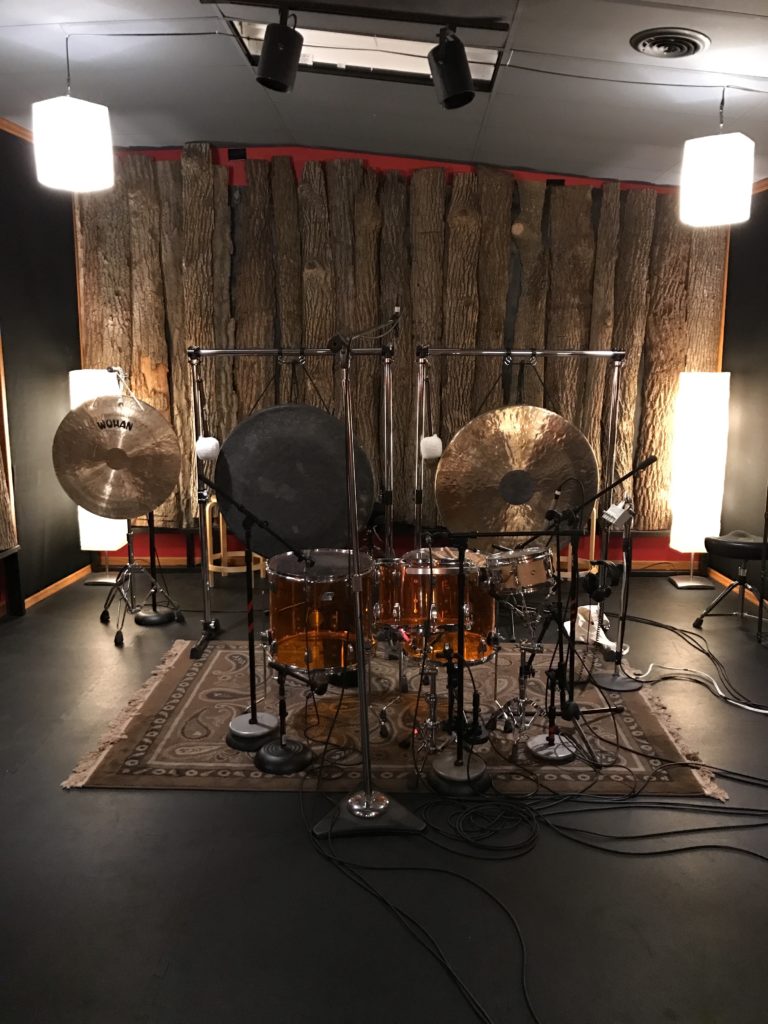
Mueller: I think the natural reaction is to try to make sense, or understand, or know. But we can’t. We’re given many details, but what they lead to, if anything, is something we struggle with in general. That being said, there’s no hint with a book like this that we have a chance of knowing. In fact, it builds an empire of not-understanding, but within that not-understanding, an odd feeling like we’re there, within it occurs. That is a peculiar situation for a human being and I think that’s why it’s so alluring.
Coulthart: You could write a long list of the questions the book presents, beginning with the House itself and its connection to other dimensions. Then there’s the Recluse’s relationship with his sister, the nature of the Swine-things, whether the visions are real (as in genuine views across time and space) or hallucinations/dreams, and so on. Inexplicabilities such as this stimulate the mind because of the gaps they create, gaps which are then filled (successfully or not) by the reader’s imagination. Whether Hodgson’s inexplicabilities are a result of inexperience or design is of no consequence, it’s how they affect the reader that matters. People who complain about such things don’t seem to realise that filling in the gaps and providing explanation destroys the frisson of the weird tale. Robert Aickman and Thomas Ligotti deal with similar disjunctions in their own work. If you want “well-constructed stories that make sense” there are thousands of examples elsewhere; many of those polished and coherent tales were being written by Hodgson’s contemporaries, none of whom are remembered or read today.
Showers: How did you each approach or engage with Hodgson’s text with regard to your own creative contributions—John’s illustrations and Jon’s soundtrack—for this edition? Did you take inspiration from any other sources?
Mueller: I was following through on some existing approaches I had been working with but tried framing them within the context of particular sections of the book—the emotional energy it expressed, the tension building and seeking catharsis, but also the moments of surreal calm, which of course get interrupted by more chaos. I bookended the work with dense gong sounds to represent the complex detail with no definition or resolution, as we’ve been discussing here. Like asking, “What do you expect here? What’s in it for you? What sense can you make of all this?”
Coulthart: I think I paid closer attention to the details than I had done in the past. If you’re illustrating a story in a fairly realistic manner then you’re forced to address certain questions of appearance that might otherwise remain unresolved while you’re reading. So the Recluse describes himself as an old man, and yet (as I think Iain Sinclair notes) he’s very active in the earlier chapters. There’s a couple of slight nods to other artists: I’ve always liked Jack Gaughan’s cover for the Ace paperback so the House in the Arena is reminiscent of his painting. And the figure floating in a fiery nimbus is a nod to Philippe Druillet who does this in some of his Lone Sloane comic strips. It only occurred to me later that Druillet was also one of the first French artists (possibly the first) to illustrate Hodgson in 1971; looking at his drawings it turns out that he had his Recluse floating through a landscape in a similar fiery nimbus.
Showers: Do you have any other thoughts on The House on the Borderland or William Hope Hodgson that you’d like to add?
Mueller: I’m fascinated by Hodgson’s personal life and how his literature came out of it. How the isolation of the sea, his hatred of it, and the torment by other sailors he experienced perhaps brought about his aim for revenge against forces that seemed to outnumber him. I admire how he potentially translated some of his many struggles with these forces into creative endeavours. I think that’s why The House on the Borderland has no resolve. These forces never really die. They just change form.
Coulthart: It’s tempting to wonder what he might have done had he survived the war, but then he wouldn’t have been William Hope Hodgson if he hadn’t also insisted on returning to the Front after having been wounded. The men of action in his novels and stories are all personae of the author, the Recluse included. Even if he had have lived twenty or thirty years more I doubt we’d have anything else like The House on the Borderland, it’s sui generis.
Jon Mueller is a Wisconsin-based artist whose aim has been to use drums, percussion and sound as a way to express something felt but not easily defined. More about his work, performances and recordings can be found at www.rhythmplex.com
John Coulthart is a World Fantasy Award-winning artist, designer and writer. His illustration and design work has been exhibited worldwide, and includes commissions for Abrams, Angry Robot, Granta, Harper Collins, Savoy Books, Tachyon, and many others. www.johncoulthart.com

